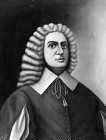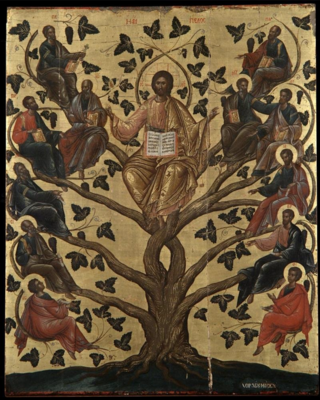
Jakob Abbadie, also known as Jacques or James Abbadie, was a French Protestant minister and writer. He became Dean of Killaloe, in Ireland.

The Last Supper is a mural painting by the Italian High Renaissance artist Leonardo da Vinci, dated to c. 1495–1498, housed in the refectory of the Convent of Santa Maria delle Grazie in Milan, Italy. The painting represents the scene of the Last Supper of Jesus with the Twelve Apostles, as it is told in the Gospel of John – specifically the moment after Jesus announces that one of his apostles will betray him. Its handling of space, mastery of perspective, treatment of motion and complex display of human emotion has made it one of the Western world's most recognizable paintings and among Leonardo's most celebrated works. Some commentators consider it pivotal in inaugurating the transition into what is now termed the High Renaissance.

From the Manger to the Cross or Jesus of Nazareth is a 1912 American drama film directed by Sidney Olcott, written by Gene Gauntier, and starring Robert Henderson-Bland as Jesus of Nazareth. Filmed on location in Egypt and in Palestine, it tells the story of Jesus's life, interspersed with verses from The Bible.

Jacques Joseph Tissot, better known as James Tissot, was a French painter, illustrator, and caricaturist. He was born to a drapery merchant and a milliner and decided to pursue a career in art at a young age, coming to incorporate elements of realism, early Impressionism, and academic art into his work. He is best known for a variety of genre paintings of contemporary European high society produced during the peak of his career, which focused on the people and women's fashion of the Belle Époque and Victorian England, but he would also explore many medieval, biblical, and Japoniste subjects throughout his life. His career included work as a caricaturist for Vanity Fair under the pseudonym of Coïdé.

The Epistle of the Apostles is a work of New Testament apocrypha. Despite its name, it is more a gospel or an apocalypse than an epistle. The work takes the form of an open letter purportedly from the remaining eleven apostles describing key events of the life of Jesus, followed by a dialogue between the resurrected Jesus and the apostles where Jesus reveals apocalyptic secrets of reality and the future. It is 51 chapters long. The epistle was likely written in the 2nd century CE in Koine Greek, but was lost for many centuries. A partial Coptic language manuscript was discovered in 1895, a more complete Ethiopic language manuscript was published in 1913, and a full Coptic-Ethiopic-German edition was published in 1919.

The Glorious Cross of Dozulé, also known as Croix d’amour in France and as Cruz de Amor in Portugal, is a project of an illuminated cross, not entirely recognized by the hierarchy of the Catholic Church, coloured white and blue 7.38 m (24.2 ft) tall with arms 1.23 m long, which means with an exact proportion of a ratio of three between the vertical and horizontal length, based on the reported apparitions of Jesus Christ to Madeleine Aumont and should to be erected in Dozulé, a small town in Normandy, located about 25 km (16 mi) from Lisieux in France.

Tréguier Cathedral is a Roman Catholic church and former cathedral in Tréguier, Côtes-d'Armor, France. It is dedicated to Saint Tudwal. The church was formerly the seat of the Bishopric of Tréguier, abolished under the Concordat of 1801, when its territories were divided between the Diocese of Quimper and the Diocese of Saint-Brieuc, known since 1852 as Saint-Brieuc-Tréguier.
Musical settings of sayings of Jesus on the cross are compositions which set seven short phrases uttered by Jesus on the cross, as gathered from the four Christian Gospels narrating the Crucifixion of Jesus. Several composers have written musical settings of the traditional collection of seven sayings, sometimes called Seven Last Words and ultima septem verba, for various combinations of voice and/or instruments. Eventually these settings became a separate form of Passion music. Perhaps the most outstanding work in this genre in the Lutheran tradition is the work by Heinrich Schütz. Joseph Haydn composed string quartets titled Die sieben letzten Worte unseres Erlösers am Kreuze.

Baigneux-les-Juifs is a commune in the Côte-d'Or department in the Bourgogne-Franche-Comté region of Central-Eastern France.

Henri Jules Charles Petiot, known by the pen name Henri Daniel-Rops, was a French Catholic writer and historian.
Matthieu Cottière (Cotterius) (1581–1656) was a French Reformed pastor at Tours and theological writer.

Ligier Richier was a 16th-century religious sculptor working in Lorraine, France and known in particular for his depictions of scenes from the "Passion of Christ". The various episodes of the Passion, between the arrest and the crucifixion of Christ, as recounted in the Gospels, were increasingly subject to representation in the Arts towards the end of the Middle Ages, in tandem with the growing popularity of the staging of theatrical mystery plays.

Dina Bélanger, RJM, in religion Marie of Saint Cecilia of Rome, was a Canadian member of the Religieuses de Jésus-Marie.
Mure is an extinct language of Bolivia. It was long considered a Chapacuran language, but the similarities are few, and are likely loans, as the Mure were missioned together with speakers of Chapacuran languages. Apart from those few words, the languages are "utterly different" according to Glottolog, a view that is shared by Birchall (2013).
Roland Doré was a 17th-century sculptor and his workshop or "atelier" produced many sculptures for the enclos paroissiaux or "parish church enclosure or closes" of Brittany. In particular his work can be seen on calvaries and in the church's south porch. He was born in 1616 and died in 1660. Little detail of his life is known but it is recorded that he practised as an architect in Landerneau, as well as running his workshop, and was recorded as calling himself the "Sculpteur du Roi". His works, all of an ecclesiastical nature, are mainly located in Léon and the north of Cornouaille. They can be taken as works by Doré's workshop rather than just by Doré himself. Brittany is particularly rich in calvaries, some of a very elaborate nature. In most cases the calvary involves both the crucifixion cross and side crosses or gibbets bearing the good and the bad robbers. Below this, on the crosspieces, were statues of those present at the crucifixion. A feature of Breton calvaries is that most of the statues were carved as a pair and effectively back to back. Doré's output was prodigious and he worked on nine monuments in Saint-Thégonnec, five in Logonna-Daoulas and four in the parish of Plougastel-Daoulas. He also received four commissions to work in Hanvec, three in Guiclan, Irvillac and Lampaul-Guimiliau and two commissions in Cléden-Cap-Sizun, Hôpital-Camfrout, Landerneau, La Martyre, Plabennec, Pleyben, Plogonnec, Saint-Nic, Saint-Servais and Saint-Urbain.

The Chartres pilgrimage, also known in French as the pèlerinage de Chrétienté, is an annual pilgrimage from Notre-Dame de Paris to Notre-Dame de Chartres occurring around the Christian feast of Pentecost, organized by Notre-Dame de Chrétienté, a Catholic lay non-profit organization based in Versailles, France. Although the pilgrimage has existed since 1983, the organization was not founded until 1991. There is also a pilgrimage in an opposite direction from Chartres to Paris called Pèlerinage de Tradition and organised by the Society of Saint Pius X
Les Sept Paroles de Notre Seigneur Jésus-Christ sur la Croix is an 1855 oratorio by Charles Gounod.

Glorious is a French Christian (Catholic) rock and worship music group, originally from Valence, Drôme, and based in Lyon, France. It was formed in 2000, following the World Youth Day, by three brothers from Valence.

Christ the Vine, also known as the Tree of Christ, is a tempera painting by Leos Moskos. Moskos was active from 1620 to 1690. Twenty of his works have survived. He was originally from Rethimno, Crete. He traveled all over the Venetian empire. He worked on the Ionian islands of Cephalonia and Zakynthos. He also worked in Venice. Two other painters with the same last name were active during the same period. They were Elias Moskos and Ioannis Moskos. All three artists painted in the same style. Leos was in Venice around the same period as Ioannis. There is strong evidence that the three were related. Famous Greek painter and historian Panagiotis Doxaras was Leo’s student.

The paintings in Besançon Cathedral comprise a total of 35 canvases listed as historical monuments, including masterpieces by artists such as Fra Bartolomeo, Jean-François de Troy, Charles-Joseph Natoire, and Charles André van Loo. Most works were executed during the 17th century, although some were produced in the 18th and 19th centuries. The largest canvases hang in the apse of the Holy Shroud and the chapel of the Sacred Heart, but other works are also stored in rooms not open to visitors, making them impossible to contemplate. Today, after the Musée des Beaux-Arts et d'Archéologie, the Cathédrale Saint-Jean in Besançon is the building with the largest number of paintings, far ahead of the Eglise Sainte-Madeleine and the city's observatory.















